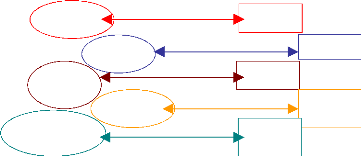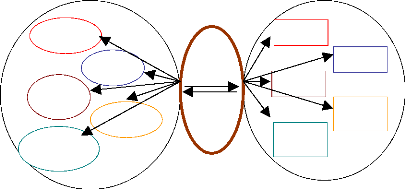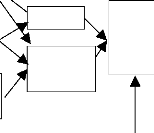II.2. PROCESS
In order to develop the pilot experience in the third district
of Bangui, activities undertaken or strategies used for information, education,
and counselling in matter of prevention and reduction of youth vulnerability to
STI/HIV/AIDS have been considered in certain cases as part of a more extended
district socio-educative system and in others as specific sub-systems.
In this pilot experience, the analysis of basic
socio-educative structures and their constitutive
elements showed that socio-educative services were not structured in a system
but were made of a number of sub-systems not working as a complete package ;
there was no coordination among them and services offered to the youths were
scattered (Figure 4).
|
1. socio-educative services
|
|
2. target population
|

School youths
SCHOOL
SOCIAL SECTOR
Street children
YOUTH CLUBS
Youth out of school
HEALTH
CENTRE
Unhealthy youth or healthly
h
Youth
information centre
All the youths of the site
Figure 4 : Illustration of the
organisation and functioning of socio-educative services offered to the youths
in the third district of Bangui.
Consequently, a more efficient, effective and coordinated
structuration [11] was envisaged in basic socio-educative services - health
centre, youth club, social action sector, school, HIV voluntary testing centre,
youth friendly centre (CIEE in French) - organized in a system in such a way
that there are possibilities of creating a dynamic interface with the youths
(figure5).
|
1. socio-educative services
|
|
2. target population
|

Youth
information
centre
YOUTH CLUB
SOCIAL SECTOR
SCHOO
L
HEALTH
CENTRE
LIP
Youths out of school
All the youths of the site
Street children
School
youths
Unheathy youths or not
Figure 5 : System functioning as an
integrated comprehensive package with possibility of a dynamic interface with
youths population.
The LIP (Local Information Pool) would serve as element of
permanent interaction with the youths (figure 4) represented in different
structures of dialogue settled in the district which
are health clubs. This system will have to function as an
integrated comprehensive package3 offering information, education
and monitoring services (IEM or IEE in French) as a whole to the youths with
their full participation. It will be called « socio-educative district
system » made of basic socio-educative and referral services.
The approach followed relies on the replication of the model
of health district system based on primary health care. This model is indeed
the pertinent entity where various actors concerned by health domain can
envisage collaborating efficiently and acting to the adequate scale [12]. The
approach followed is systemic where the health district is conceived not as a
standard and catch-all modality of service organisation, but as a model to
adapt to circumstances, without forgetting the aim of a health service in the
urban context.
Thus, the model of health district has three essential
dimensions [12]. The first is spatial and demographic. It is
the definition of a precise population, living in a defined geographical zone,
corresponding or not to an administrative zone, on which the health authority
is responsible. This dimension of the model enables to introduce the notions of
zone of responsibility, health map, target population, and population
coverage.

The second dimension concerns the management and
authority functions. Exercised by the health authority, they range
from supervision activities and logistics to the financial management. This
managerial dimension4 of the model enables to re-examine the notions
of formal and functional authority, supervision and control, community
participation, and enabling of the inter sector action.
3 An integrated system of health is a system where elements
are organized, tidy and coordinated in view of common objectives: in our case,
it is the agreement to bear medical costs of problems related to prevention and
reduction of youth vulnerability to HIV/AIDS in the third district of Bangui
4 Management Functions, Chapter 1, page 11, Management
Fundamentals, Concepts-Applications-Skill Development. Robert N.Lussier, Ph.D.,
Springfield College, Springfield, Massachusetts, 2000 South -Western College
Publishing, a division of Thomson Learning.
The third dimension deals with organisation functions
concerning treatment, services and activities. This technical
dimension re-evaluates for the area the notions of users' circuit, services'
scales and relations among them, delegation or decentralisation of competences
and technology, or of reference system and counter reference system of patients
also.

The model of health district can be applied to the urban
context of the 3rd district without losing its coherence or abandoning its end:
the effective coverage of the population by Primary Health Care. [4]
The replication stages of the development and organisation of
such a system in a more extended socio-educative system are described in
documents of general policy, organisation, management, animation and training
designed during this pilot experience. Five strategic and operational axes have
been followed:

i. Development of an Executive Educative
Team.
To develop the various fields of activity of the pilot site,
an Executive Educative Team essentially made of volunteers identified and
chosen by the NGO «Ambassade Chrétienne» has been put in
place. Its members perform this social function without any remuneration other
than that of their habitual functions.
The Executive Educative Team exercising both technical and
administrative functions matching the profile of a social animator: teacher,
communicator, health professional, youth and animation councillor, and
management specialist.
|
The essential function of this team is the supervision of the
young supervising peer educators responsible of the organisation, management
and animation of the communication area (LIP, Health clubs). The structuration
in team and the work organisation have been a constant priority during the
whole process.
|
Health club in «castor» area of communication

Communication channels have been created to enable the
participation of everyone to the making of decisions
, tasks sharing, team spirit (responsibility in the group), and
the evaluation of activities through active research
from opinions of the others (meetings, folder for the circulation
of documents, calendar of activities, supervision notebook, etc).

Decisions were turned into « instructions »
preventing the member of the Executive Educative Team in charge of their
application of the pattern and the evaluation deadline. This has led to the
setting of a local information system containing management tools for the
organisation and functioning of the pilot site and a standard supervision
kit.
ii. Development of the coverage.
The global approach for the development of the coverage was
carried out at two levels: 1. Settlement of a basic socio-educative service
The council has been divided into 30 geographical units called
communication areas (CA), corresponding as much as possible to quarters
following the administrative structure (division). Each communication area is
under the responsibility of a young supervisor peer educator (SPE) and hosts a
local information pool (LIP), a potential space made up of 10 young peer
educators and a health club (HC) which pools representatives of youth
association (ASS) and vulnerable groups (VG) identified (street children, loose
girls, etc...).

In order to raise awareness for an individual search of
solutions to their problems, the social animation of youths is realised
throughout the health clubs considered as participation structures.

The local information pool has been organised structurally and
functionally to serve as interface between the participation and dialogue
structure of the youth (health club) and the basic socio-educative services.

The analysis/observation of the interaction between the local
information pool (LIP) and the health club on one hand, and the local
information pool (LIP) and the basic socio-educative structures on the other,
depending on the problem to solve, has permitted the understanding : + of
conditions to observe for the settlement of coordination and orientation
mechanisms of

the inter sector action ;
+ of each structure in terms of objectives to meet and minimum
package of activities to to

carry out;
+ of the technical, material and financial necessary support
related to the needs of youths.
Given the huge size of communication areas, alternative
approaches have not as yet been
developed to complement the coverage of the youth sub-urban
populations living at very
long distance from the local information pool (LIP): mobile
services of peer educators

for instance.

2. Establishment and rationalisation of the organisation
and functioning of a central structure as a Reference Information, Education
and Counselling Centre for basic socio-educative services. The Reference
Information, Education and Counselling Centre (Centre d' Information,
d'Education, et d'Ecoute des jeunes / CIEE in French) has been developed and
organised as a reference structure for the information, education and
counselling of youths in connection to the 30 local information pools. The
space organisation within the CIEE has been done taking into account the needs
in information and education (meeting room, library, video room), the needs in
management and follow -up of activities (office of the Executive Educative
Team),
|
1st stage
|
|
2nd stage
|
|
3rd stage
|
|
Transfer
|
|
Transfer
|
-Voluntary Testing -Behavioural analysis
-Risk
Mapping
- Census
Confidence
Quantita Rational
tive solutions
knowled to
ge of problems
problems studied
Continuous assessment and control system

Systematic study of priority problems

Identification and assessment of problems
IEC/CBC Treatment

the needs in management and follow-up of the equipment,
materials and furniture (store), the needs in the counselling of youths
(counselling room), the needs in management and follow up of activities in the
30 communication areas by the young supervisor peer educators (SPE room), and
the needs in training (conference room).


The functionality criteria, the composition, the localisation
and a standard kit of educative and didactic material for each socio-educative
structure («CIEE», LIP, and Health Club) have been defined.
iii. Development of activities.
From the needs felt by youth population and with their full and
active participation, three complementary and simultaneous stages have been
followed in the development of activities:

|
Figure 6 : Scheme of the development of
activities
|
|
|
Transfer
|
| 


